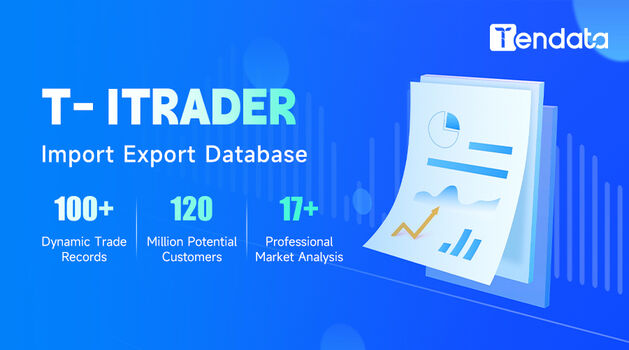 Trade Data
Trade Data
 2024-02-07
2024-02-07
China is South Korea's most important trading partner, serving as its largest importer and exporter. The trade industry of South Korea is closely intertwined with China. Even though South Korea's exports to the United States surpassed those to China for the first time in 20 years in December 2023, China remains South Korea's largest trading partner for the entire year. The export value to China accounts for 22.8% of South Korea's total exports, surpassing the second-ranked United States by 6.7 percentage points. The longstanding historical ties and close industrial and supply chain relationships between China and South Korea have facilitated a mutually beneficial trade relationship, leveraging each other's resource advantages. When you want to export products to South Korea, how can you understand the specific market situation of South Korean industries? Use customs data to quickly assist you in developing clients in the South Korean market!

Overview of China-South Korea Bilateral Trade
Customs data shows that China's exports to South Korea amount to $162.62 billion. China's main exports to South Korea include electrical and electronic equipment ($50.71 billion), machinery, nuclear reactors, boilers ($17.34 billion), and inorganic chemicals, precious metal compounds, isotopes ($12.77 billion). Over the past 31 years, China's exports to South Korea have grown at an annualized rate of 12%, facing a deficit for the first time in 2023.
Customs data also indicates that South Korea exports $155.79 billion worth of goods to China. South Korea's major exports to China include electrical and electronic equipment ($72.44 billion), machinery, nuclear reactors, boilers ($13.08 billion), plastics ($12.44 billion), and organic chemicals ($11.33 billion). Over the past 26 years, South Korea's exports to China have grown at an annualized rate of 11.4%.
In labor-intensive product categories such as textiles and raw materials, and furniture, China continues to maintain its competitive advantage. China's main competitors in these product categories include Vietnam, Indonesia, and Japan.
Looking at South Korea's export structure in 2022, among the customs-coded two-digit categories (AG2) with a relatively high proportion of exports to China, ore and sand (HS26) has the highest share at 90.7%, followed by photographic and cinematographic products (HS37) at 78%. Categories with proportions between 40% and 49.9% include copper (HS74) at 49.4%, salt and sulfur (HS25) at 49.3%, organic chemicals (HS29) at 45.8%, glass and glassware (HS70) at 45.4%, essential oils and resins (HS33) at 44.6%, and optical or medical equipment (HS90) at 40.8%.
In comparison, there are still many product categories with a relatively small proportion of exports to China, leaving room for expansion. For example, synthetic staple fibers (HS55) as textile raw materials have a proportion of 9.9%, cotton (HS52) at 7.5%, and silk (HS50) at 6%. Given the enormous scale of the Chinese textile and apparel market, increasing imports of raw materials from supplying countries is an important measure for stabilizing the industry and maintaining competitiveness. China's share of exports of South Korean pharmaceuticals (HS30) is only 3%, and it imports only 1.5% of South Korean coffee and tea (HS9). With many similarities in culture between China and South Korea, South Korea has its own advantages and characteristics in these two categories, and expanding imports of related products can provide Chinese consumers with a more diverse selection.
How to Develop Foreign Trade Clients Based on South Korean Customs Data?
· Obtain South Korean Customs Data: South Korean official customs data is not publicly available. Therefore, to obtain data on imports and exports to South Korea, you can use customs data companies like Tendata for viewing. Before selecting a customs data provider, ensure the timely and stable updating of data for making accurate market decisions.
· Analyze Product Categories and Industries: Conduct market analysis using customs data to understand which products are worth investing in, have high import demand in South Korea, and can generate higher profits. Identify products with potential in the South Korean market to adjust your market strategy. Understand the quotes of major competitors and their market strategies, providing reference for your business development.
· Identify Potential Clients: Based on customs data, identify potential clients interested in your products or services. This can be achieved by filtering specific product categories, values, or quantities. Tendata provides information on over 200,000 South Korean importers, allowing you to filter importers with demand for your products.
· Develop Marketing Strategies: Based on the needs of potential clients, formulate targeted marketing strategies. This may include pricing advantages, market promotion activities, product positioning, and service advantages.
· Establish Contacts and Networks: Tendata provides contact information for each potential client, allowing you to directly contact top executives of South Korean importers through social media platforms, email, LinkedIn, etc., to establish contacts with key individuals.
· Continuous Market Monitoring: Regularly update and monitor South Korean customs data to keep abreast of the market. Adjust your strategy as needed to adapt to market changes.
>>>Click to Get 91 Countries' Customs Data for Free<<<
The first step in international trade is to understand the trade information of both buyers and sellers. In the era of big data, enterprises that can effectively use customs data will find it easier to stand out in a competitive environment. For import and export businesses, trade data is one of the most valuable types of data, enabling companies to gain in-depth insights into their market conditions from multiple dimensions, including market trends, customers, and competitors. Follow Tendata to see how to analyze the market using customs import-export data.
I. Obtain Customs Data for 91 Countries and Identify Suitable Customers
Tendata's customs database provides real-time global customs data covering 91 countries, data for 42 countries along the Eurasian route, 100+ billion real-time trade data, and information on 180 million global enterprises. It helps you understand global market trade trends and distribution, allowing you to quickly, accurately, and scientifically target hot-selling countries and emerging markets for your products. >>>Consult Online
II. Present Trade Details and Directly Contact Buyers
Import and export data is one of the fundamental tools for Importers & Exporters to develop customers. It enables them to go from understanding the market to knowing competitors and then to developing customers.
Tendata iTrader provides various search criteria to examine details of each cross-border transaction, such as importer & exporter information, product categories, transaction quantities, transaction amounts, country of origin, carrier, port of departure, and port of arrival. Quickly and in bulk, obtain buyers based on their purchase volume, price, and preferences, positioning your target customers. By comparing historical data, quickly identify genuine buyers, providing you with precise opportunities for successful transactions. >>>Click to Get Sample Online
III. Professional Market Analysis to Seize Opportunities for Transactions
Which website is good for querying customs data? This is something many import and export enterprises are very concerned about!
Tendata's customs data platform offers nearly 20 types of customizable, multi-dimensional market analysis reports (>>>Click to Use Data for Free Online). It allows for easy capture of the main markets and customers of competitors. Through the analysis of the volume and price of peer transactions and the supply chain analysis of target customers, detailed information on customer bills of lading, competitor details, and intelligent generation of various data analysis reports highlights your competitive advantages, helping you seize more market share.

>>>Consult with 1-on-1 Online Customer Service<<<
Category
Leave Message for Demo Request or Questions


 T-info
T-info T-discovery
T-discovery

 My
Tendata
My
Tendata Market Analysis
Market Analysis Customer
Development
Customer
Development Competitor
Monitoring
Competitor
Monitoring Customer Relationship
Customer Relationship





































































































































